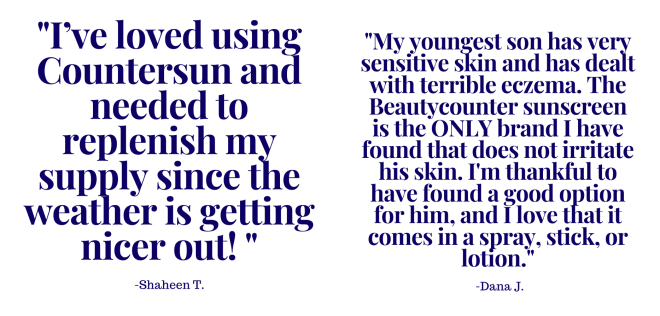It’s summertime — the season of fun in the sun…which also means IT’S SUNSCREEN SEASON! But the thing is, choosing sunscreen can be confusing. Is it enough to just choose an SPF, or do I need to consider other factors, too? How much SPF do I need anyway? And there’s the environment to consider, too, right…?
Not to worry — I’ve got you covered! All YOU have to worry about is having a blast outside this summer (and using safe sunscreen, of course, which you’ll learn more about in this post). I’ll be sharing information about SPF, the difference between chemical and mineral sunscreen, vetting sunscreen brands for safety, and details on my favorite sunscreen for our family, too!:
The first thing to be aware of: There’s more to sunscreen than SPF.
Just a few years ago, I was a big advocate of sunscreen — but I didn’t know there was more to consider than just protecting your skin from burns. We spend lots of time at the beach, so each summer I’d stock up on Target’s Up & Up spray sunscreen, SPF 30, and think I was all set. (Turns out, although that sunscreen will keep my skin from burning, there are SO MANY better choices.)
In the past four-ish years, I’ve learned much more about sunscreen. Here are some things to be aware of when choosing sun protection for you and your family:
- What are we protecting against anyway?
UVA Rays: These rays contribute to premature aging of the skin as well as skin cancer.
UVB Rays: These are the rays that cause painful sunburn as well as skin cancer.
Blue Light: Found in the sun as well as technology (which we’re all in front of ALL the time!), blue light can cause signs of aging in the skin. (No, thanks!)
2. How much SPF do I need?
There’s much less variation in SPF than I once thought. For example:
SPF 15 blocks 93% of UV rays
SPF 30 blocks 97% of UV rays
SPF 50 blocks 98% of UV rays
In fact, the FDA is concerned that claims of excessively high SPF values give users a false sense of protection, leading to overexposure to UVA rays that increase the risk of long-term skin damage and cancer. They’ve even suggested capping ratings at 60 SPF.
3. What’s the difference between a chemical sunscreen and a mineral sunscreen?
Chemical sunscreens protect the skin from UV rays by scattering the rays. There’s concern that this process can cause free radicals, harming our skin cells. Chemical sunscreens typically contain oxybenzone, which is the chemical banned in places like Hawaii and Key West because it can damage coral reefs. It also isn’t great for us! Oxybenzone disrupts our hormones, accumulates in our bodies, and is allergenic. Hard pass.
Mineral sunscreens use a physical barrier to block the UV rays from penetrating our skin. They’re definitely the safer option between the two — both for your health and our oceans.
4. Tell me about your family’s favorite sunscreen!
We love using Beautycounter sunscreen at our house. All of Beautycounter’s sunscreen is mineral sunscreen. It’s also formulated with non-nano zinc oxide, meaning the particle size isn’t small enough to be absorbed into the skin. (Yay!)
Beautycounter sunscreen mists use a non-aerosol bag-on-valve technology to keep you safe. Other spray sunscreens have a high inhalation risk due to the ingredients and delivery system. (As I mentioned, I used to be ALL ABOUT traditional spray sunscreen. Now I know better!)
Beautycounter has lots of great sunscreen options, including:
–a face sunscreen (lightweight, easy to rub in, and wears well under makeup)
–a tinted face moisturizer with SPF (one of my all-time favorite products!)
–sunscreen lotion (my go-to for pre-pool or beach application)
–sunscreen mist (perfect to quickly and easily re-apply when you’re busy having fun outside — and there’s a tinted option, too!)
–sunscreen stick (sooo handy for quick application on kiddos’ faces, shoulders, ears, etc.)
P.S. If you’re a first-time Beautycounter customer, use the code CLEANFORALL20 to save 20% on your order (including sunscreen)!
5. I’ve used safer sunscreens in the past and didn’t love them. They didn’t rub in well or they made my skin look or feel weird. How do Beautycounter’s stack up?
SUCH a good question. If you’ve used mineral sunscreens in the past you might have been left looking a bit like Casper the Friendly Ghost. I love that Beautycounter’s sunscreens do NOT have that effect! They also tend to work well for all members of the family, even those with especially sensitive skin. (We’ve been using Countersun products on Maggie since she was a baby and they’ve worked so great for her!)
Here’s what a couple of my customers have to say about their experience using Countersun products:

6. What about finding other safe sunscreen brands, or vetting the brand I already use?
Environmental Working Group is my go-to resource for checking the safety of products (personal care products, baby products, cleaning products, and more!), and they have a great sunscreen guide you might find helpful. You can peruse that for brands they recommend, as well as use their search function to find safety information on brands you might currently be using.
Check out EWG’s guide to sunscreens here!
I hope that was a helpful Sunscreen 101 overview! Here’s to safe fun in the sun alllll summer long.

